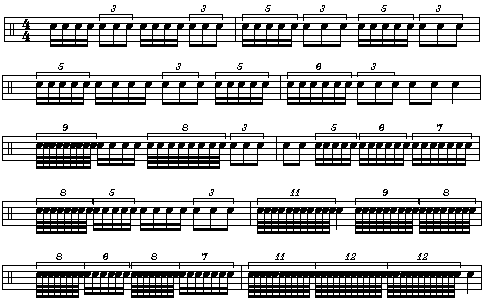Fun With Odd Note Groups
Incorporating odd note groups in your playing can give you new ideas not to mention cool new sounds.
Mix It Up
The way you practice is the way you will play when you're on the gig. If your normal practice routine consists
of exercises made up of the standard note groups (like those shown in Example A), you are missing out on a lot
of cool possibilities.
Example A

Take a look at the odd note groups in Example B, below (Note that "odd" refers to less often played, as opposed to odd numbers). First, practice them on a practice pad or snare drum. Play each note group four times and go to the next without stopping. This will help you develop the feel for playing these odd groups and transitioning from group to group evenly. After you become comfortable working with these odd groups, practice the exercises in Example C. Play them slowly at first and use a metronome.
Example B

Example C

Applications on the Drumset
If you attempted to play the 10 bars of exercises in Example C, you're probably wondering whether this stuff
has any practical application. Trust me, once you become comfortable switching between odd and even note
groups, you will be able to use them not only in the context of an extended drum solo but for fills as well.
To reach that level, however, does take lots of practice.
In addition to the examples I've written here, I encourage you to make up your own combinations of odd and even note groups for practicing. You should also play around with adding accents in various places to give them a little more kick After you get comfortable playing these exercises on a drum pad or single drum, apply them around the drumset. You'll be surprised at how good they can sound with a little woodshedding on your part.
Until next time: Think "Odd" and Stay loose!
